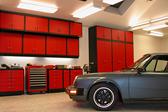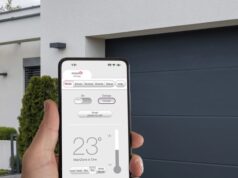
Garage and workshop lighting needs to be bright and functional – not just for safety, but also for security.

Photo courtesy of Charlie Kindel.
Used under the Creative Commons Attribution 3.0 Unported license.
A garage is a very functional part of the home. It’s where we park our cars and perform maintenance, and many people use it as a workshop area as well. Each of these various tasks has different lighting requirements, just as similarly scoped tasks might have in a kitchen, and for this reason garages, especially if they’re also used as workshops, benefit greatly from well designed lighting.
Garage lighting design fundamentals
Overhead fluorescent lights are among the best options for the main light fixtures in a garage. As well as providing enough light to safely drive in and out of the garage, evenly spaced fluorescent lighting should also provide ample light to use the area as a general workspace, and help to eliminate shadows. As a source of ‘general light’ in a garage, this is by far the most common and cost-effective choice.
If you’re designing from scratch, new laws will fairly significantly limit the amount of lighting you can wire up directly in your garage though. Under the new Australian lighting regulations, garages are limited to 3W of lighting per square metre of floor space.
There are various controls you can install to increase this figure slightly, but as a rule of thumb you’ll now be somewhat limited in terms of what you’re able to install. This doesn’t mean your garage can’t be well lit – it’s mostly a matter of understanding the regulations and how you can design to take advantage of the many other ways to introduce light where it’s needed.
Setting up moveable task lights for example, such as drop-down and clip-on lights, will allow you to do more intricate work in different parts of the garage as required. Likewise, fixed under-shelf LED lighting and movable workbench lamps provide effective task lighting where it’s needed most often. The per-metre lighting regulations don’t include lamps and fittings that aren’t permanently wired in.
Daylighting in garages
Because garages are often designed without windows (or with only tiny windows), a skylight, clerestory windows, transoms or similar daylighting features will provide plenty of bright, natural light during the day. This, in conjunction with light coloured walls, ceilings and flooring surfaces will help to make the garage look less gloomy and more evenly lit. It will also help you save money if you spend any amount of time in your garage during daylight hours, and will help you to add some much-needed ventilation.
Security and garage lighting
If your garage leads out to a yard, you may wish to install external lighting with a switch inside the garage as well as inside the house, or ensure that a motion sensor is in range as you exit the garage. Likewise, if you are using an automated lighting system, you should be able to program the lighting in your garage to your preference using specific scene modes. A remotely controlled garage door can also be set up to trigger garage lights, so as to provide adequate lighting to park and exit your car safely.
As well as improving safety in a garage, well designed garage lighting can also serve to improve security and make the space look a whole lot better.





